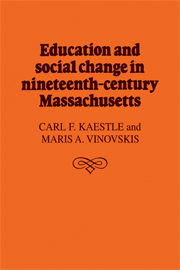Book contents
- Frontmatter
- Contents
- List of tables and figures
- Preface
- 1 Education and social change: Massachusetts as a case study
- 2 Trends in school attendance in nineteenth-century Massachusetts
- 3 From apron strings to ABCs: school entry in nineteenth-century Massachusetts
- 4 The prospects of youth: school leaving in eight Essex County towns
- 5 From one room to one system: the importance of rural–urban differences in nineteenth-century Massachusetts schooling
- 6 Education and social change in two nineteenth-century Massachusetts communities
- 7 Trends in educational funding and expenditures
- 8 The politics of educational reform in mid-nineteenth-century Massachusetts
- 9 Conclusion: the triumph of a state school system
- Appendix A Statistical tables
- Appendix B Definition of the variables contained in Tables A2.1 through A2.5, Appendix A
- Appendix C Discussion of adjustments, estimates, and extrapolations made in calculating Tables A2.1 through A2.5, Appendix A
- Notes
- Bibliography
- Index
7 - Trends in educational funding and expenditures
Published online by Cambridge University Press: 05 October 2010
- Frontmatter
- Contents
- List of tables and figures
- Preface
- 1 Education and social change: Massachusetts as a case study
- 2 Trends in school attendance in nineteenth-century Massachusetts
- 3 From apron strings to ABCs: school entry in nineteenth-century Massachusetts
- 4 The prospects of youth: school leaving in eight Essex County towns
- 5 From one room to one system: the importance of rural–urban differences in nineteenth-century Massachusetts schooling
- 6 Education and social change in two nineteenth-century Massachusetts communities
- 7 Trends in educational funding and expenditures
- 8 The politics of educational reform in mid-nineteenth-century Massachusetts
- 9 Conclusion: the triumph of a state school system
- Appendix A Statistical tables
- Appendix B Definition of the variables contained in Tables A2.1 through A2.5, Appendix A
- Appendix C Discussion of adjustments, estimates, and extrapolations made in calculating Tables A2.1 through A2.5, Appendix A
- Notes
- Bibliography
- Index
Summary
Little effort has been made to analyze either the sources of educational funding or the nature of school expenditures in nineteenth-century Massachusetts. The financial aspects of educational development have been generally ignored. Part of the explanation for the dearth of financial studies of education is that it is difficult to obtain the necessary data and, perhaps, that the subject impresses many as dry or unimportant. This situation is unfortunate, because financial considerations played a large role in decisions made about education at both the state and the local level. Using state and local records, we consider briefly in this chapter some aspects of school finance and how they influenced school policy.
Public and private school expenditures
One underlying factor that influences the financial strain of mass education in any society is the number of children relative to the number of adults. This statistic is a version of what demographers call a dependency ratio. The education of children requires considerable energy and resources. Whether the parents undertake this function or share it with other institutions, such as churches or schools, the extent of the burden of education depends to a large degree on the relative number of children who need formal or informal training. Societies with a high proportion of young children have to devote a larger percentage of their resources to educating youngsters than do those with relatively fewer children.
- Type
- Chapter
- Information
- Education and Social Change in Nineteenth-Century Massachusetts , pp. 186 - 207Publisher: Cambridge University PressPrint publication year: 1980

